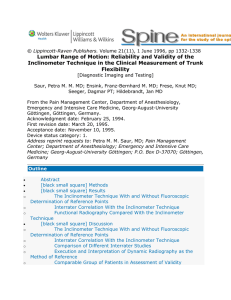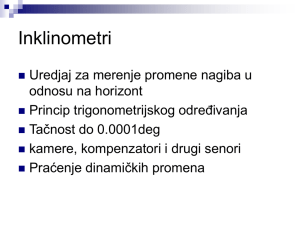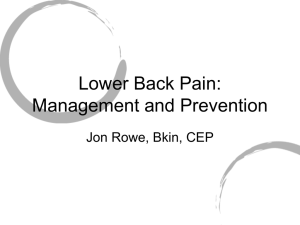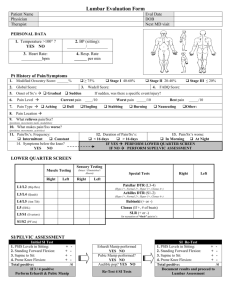lumbar range
advertisement
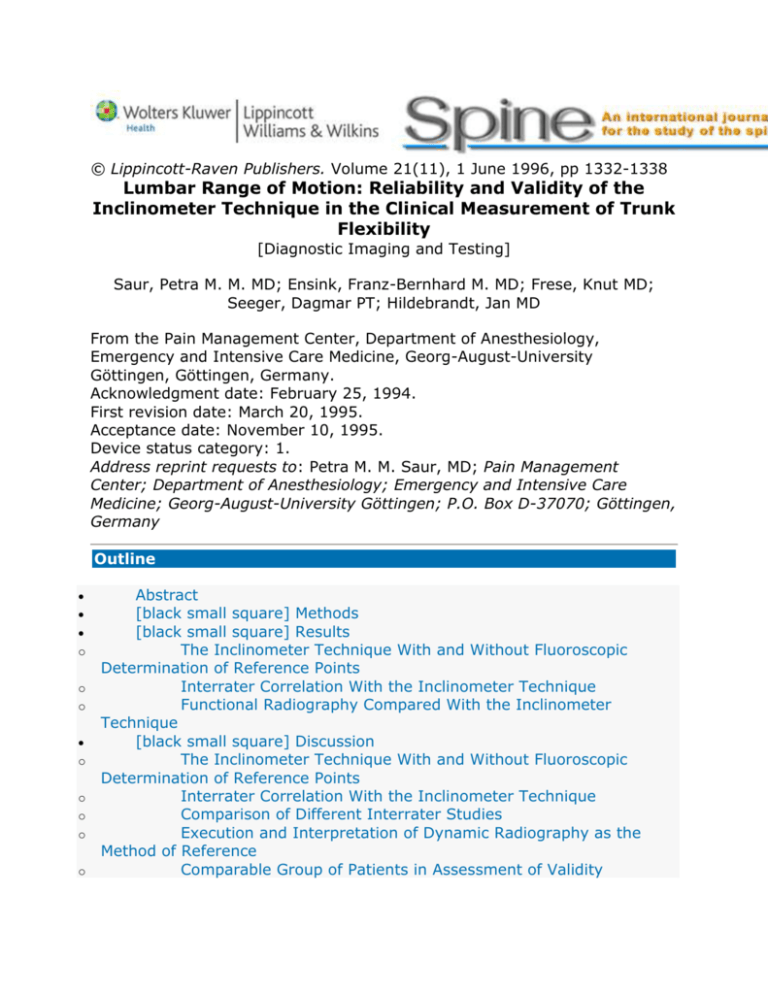
© Lippincott-Raven Publishers. Volume 21(11), 1 June 1996, pp 1332-1338 Lumbar Range of Motion: Reliability and Validity of the Inclinometer Technique in the Clinical Measurement of Trunk Flexibility [Diagnostic Imaging and Testing] Saur, Petra M. M. MD; Ensink, Franz-Bernhard M. MD; Frese, Knut MD; Seeger, Dagmar PT; Hildebrandt, Jan MD From the Pain Management Center, Department of Anesthesiology, Emergency and Intensive Care Medicine, Georg-August-University Göttingen, Göttingen, Germany. Acknowledgment date: February 25, 1994. First revision date: March 20, 1995. Acceptance date: November 10, 1995. Device status category: 1. Address reprint requests to: Petra M. M. Saur, MD; Pain Management Center; Department of Anesthesiology; Emergency and Intensive Care Medicine; Georg-August-University Göttingen; P.O. Box D-37070; Göttingen, Germany Outline o o o o o o o o Abstract [black small square] Methods [black small square] Results The Inclinometer Technique With and Without Fluoroscopic Determination of Reference Points Interrater Correlation With the Inclinometer Technique Functional Radiography Compared With the Inclinometer Technique [black small square] Discussion The Inclinometer Technique With and Without Fluoroscopic Determination of Reference Points Interrater Correlation With the Inclinometer Technique Comparison of Different Interrater Studies Execution and Interpretation of Dynamic Radiography as the Method of Reference Comparable Group of Patients in Assessment of Validity o Validity of the Inclinometer Technique for Measurement of Lumbar Range of Motion by Comparison With Radiography Acknowledgment References Graphics Figure 1 Figure 2 Figure 3 Table 1 Abstract^ Study Design: This study examines the reliability and validity of measuring lumbar range of motion with an inclinometer. Objectives: To find out whether a manual determination of the reference points for measuring lumbar range of motion is as reliable as radiologic determination for positioning the inclinometers, lumbar range of motion was determined in degrees by evaluating radiographs and by using the inclinometer technique of Loebl. Summary of Background Data: Reliability and validity of the inclinometer technique as a clinical measurement of trunk flexibility were investigated. Fifty-four patients participated in the study. Methods: Lumbar range of motion measurements were taken with and without radiologic control of the T12 and S1 vertebrae as reference points for positioning of the inclinometers. An interrater correlation was done of the inclinometer techniques of a physician and a physiotherapist. Functional radiographs were investigated in a standing position. Lumbar range of motion measurements based on radiographs and those taken using the inclinometer alone were correlated to validate the inclinometer technique. Results: Lumbar range of motion measurements taken with and without radiologic determination showed a very close correlation (r = 0.93; P < 0.001). Flexion alone also demonstrated a close correlation (r = 0.95; P < 0.001), whereas extension showed a somewhat smaller correlation (r = 0.82; P < 0.001). Total lumbar range of motion (r = 0.94; P < 0.001) and flexion (r = 0.88; P < 0.001) were closely related, as indicated by the interrater correlation, whereas extension (r = 0.42; P < 0.05) showed a lesser correlation. Correlation of the measurements taken radiographically and by inclinometer demonstrated an almost linear correlation for measurements of the total lumbar range of motion (r = 0.97; P < 0.001) and flexion (r = 0.98; P < 0.001), whereas extension (r = 0.75; P < 0.001) did not correlate as well. Conclusions: The noninvasive inclinometer technique proved to be highly reliable and valid, but the measurement technique for extension needs further refinement. Measurement of lumbar range of motion (LROM) is a routine method in the examination of patients with low back pain. Such measurements are used to determine the functional limits of the spine and to follow therapeutic response.14,18 Clinically helpful measurements need be 1) able to differentiate between pelvic and spine mobility, 2) reliable and valid, 3) cost effective, and 4) easy to administer. LROM measurement with the inclinometer has been proven reliable and valid in several studies.14,17,18,22,24 This study was done to find out whether a manual determination of the reference points is as reliable as radiologic determination for positioning the inclinometers. Based on the satisfying intrarater correlations found by Beattie et al,2 Gauvin et al,8 Hyytiäinen et al,10 Keeley et al,11 Panzer,19 and Paquet et al,20 we investigated the interrater correlation to determine the influence of different investigators. Moreover, the aim of this study was to prove the validity of the inclinometer technique compared with the more invasive technique of dynamic radiography, which is usually taken as a valid diagnostic procedure for assessing LROM. [black small square] Methods^ Patients. Fifty-four patients from an intensive rehabilitation program for chronic low back pain in Göttingen took part in the study.21 Inclusion criteria were: 1. Chronic low back or leg pain 2. Continuous duration of pain for more than 6 months despite treatment 3. More than 8 weeks of inability to work at the beginning of the low back pain program; or more than 3 months of partial inability to work; or serious workplace problems, threatening the person's employment status 4. Age 18 to 60 years 5. German language proficiency 6. Voluntary written formal consent Exclusion criteria were: 1. Cardiopulmonary diseases with decreased exercise tolerance 2. Diseases of the locomotor system that made it impossible to participate in the sports therapy parts of the program 3. Diseases with a likely potential for the development of new episodes of pain due to specific strains (i.e., subacute radicular pain after disc prolapse) 4. Broca index indicating excessive obesity Inclinometer Measurements and Determination of Reference Points With and Without Fluoroscopy. The upper edge of the sacrum and the lower edge of the T12 vertebra were palpated in patients in a standing position. Commercially available inclinometers of the type made by Dr. Rippstein (Plurimeter-V; La Conversion, Switzerland) were positioned with their 2.5 × 10-cm platforms on these reference points, and LROM was determined in degrees using the technique described by Loebl.12 The Plurimeter-V inclinometers can be zeroed by an adjustment in 2° intervals. Measurements were taken first in neutral, then in maximum flexion, and finally in a maximum extension position. In neutral, the patient was asked to stand in a comfortable position with his hands hanging without any effort toward the ground. From this position, he had to perform maximum flexion followed by maximum extension with his knees straight, especially at the end of movement. The middle of the platform of one inclinometer was put on the spinous process of T12, and the second inclinometer was set on the spinous process of S1. The inclinometers were zeroed and the movement of the lumbar spine was read directly from the scale of the inclinometer at the extremes of flexion and extension. To get only the LROM, the readings of the lower inclinometer were subtracted from those of the upper inclinometer. Next, the upper edge of the sacrum and the lower edge of the T12 vertebra were marked under fluoroscopy (Arcoskop 110 3 D; Siemens, Mainz, Germany). This enabled a comparison of measurements obtained by the dual-inclinometer technique with and without fluoroscopic determination of the reference points. Then, corresponding measurements were taken based on these marked reference points. Reliability of Clinical Lumbar Range of Motion Measurements by Interrater Correlation. A physician and a physiotherapist measured LROM independently using the inclinometer technique after palpating the reference points. Measurements took place at a maximum time interval of 2 days. Radiographic Techniques and Interpretation. In agreement with regard to Dvorák et al 7 and other authors,2,9,12,14 dynamic radiographs in neutral, maximum flexion, and maximum extension of the lumbar spine were taken as the reference standard for measurement of LROM. Radiographs were taken laterally in a standing position. We developed a special pelvic frame for these measurements that locked the patient's pelvis between two padded aluminum tubes. The distance between this device and the x-ray tube was 1.50 m; electric current was 85 kV. All radiographs were done with the Gigantos Optimatic RD 230701 system manufactured by Siemens. Interpretation of the radiographs was done by drawing a line at the upper edge of the sacrum and at the lower edge of T12. Straight lines were drawn perpendicular to these lines. Their point of intersection forms an angle. The LROM in flexion can be measured by subtracting this angle on the radiograph in flexion from the angle on the radiograph in neutral. The LROM in extension is the difference between the angle in neutral from that in extension, measured in the same way. During dynamic radiography, LROM was measured by the inclinometer technique, as described earlier. Statistics. Correlations between the clinical measurements and the interrater correlations were described by the Pearson product-moment correlation coefficient, using the BMDP 4M statistics package (Biomedical, Berkeley, California). In spite of the fact that-because of the large number of patients-correlation coefficients larger than 0.3 at a level of 5% were already significant, the limit for clinical significance of reliability and validity in the investigation was set at values larger than 0.7. Means and standard deviations were calculated for all measurements. The significance of the correlation coefficients r were calculated and presented below. [black small square] Results^ The Inclinometer Technique With and Without Fluoroscopic Determination of Reference Points^ Fifty-four patients were examined by the inclinometer technique before and after radiologic determination of reference points. Mean total LROM after the palpatory determination of the reference points was 50.1° (SD ± 15.6°), and with fluoroscopy, 52.7° (SD ± 14.7°). Mean flexion was calculated under clinical conditions as 38.7° (SD ± 12.9°), and with radiographic control, 40.9° (SD ± 12.0°). Without radiography, mean extension was measured as 11.4° (SD ± 4.7°), and after radioscopy, 11.8° (SD ± 4.8°; Figure 1). Figure 1. Inclinometer technique with and without radiographic control, showing marking of T12 and S1 as reference points, with correlation coefficients (r). Correlations between measurements taken with and without fluoroscopically controlled reference points of T12 and S1 were significantly high for total LROM (r = 0.93; P <= 0.001) and flexion (r = 0.95; P <= 0.001). Extension, however, showed a lesser correlation (r = 0.82; P <= 0.001). Interrater Correlation With the Inclinometer Technique^ In a subgroup of 48 patients, mean total LROM was calculated by one examiner (physician) to be 54.7° (SD ± 12.7°) and by another examiner (physiotherapist) as 53.3° (SD ± 13.1°). Mean flexion was measured at 43° (SD ± 11.3°) by the physician and at 44.1° (SD ± 11.7°) by the physiotherapist. Mean LROM in extension was 11.7° (SD ± 5°) for the physician and 9.2° (SD ± 4.1°) for the physiotherapist (Figure 2). Figure 2. Mean lumbar range of motion as measured by two different examiners using the inclinometer technique, with correlation coefficients (r). Interrater reliability was calculated for this subset of patients for the inclinometer technique. The results of the inclinometer measurements showed a high correlation for total LROM (r = 0.94; P <= 0.001) and flexion (r = 0.88; P <= 0.001) between both examiners, whereas extension (r = 0.42; P <= 0.05) was barely correlated. Functional Radiography Compared With the Inclinometer Technique^ The radiographic technique resulted in a mean LROM of 46.2° (SD ± 14.8°). The inclinometer technique showed a mean LROM of 44.4° (SD ± 14.6°). Flexion was measured as 36° (SD ± 13.4°) by radiography and 33.7° (SD ± 13.5°) by the inclinometer technique. Mean extension was 10.2° (SD ± 3.6°) by radiography and 10.7° (SD ± 3.3°) by inclinometer (Figure 3). Figure 3. Mean lumbar range of motion as calculated by radiographic and inclinometer techniques, with correlation coefficients (r). Inclinometer measurements of LROM were checked for validity by comparison with dynamic radiographs of the lumbar spine in 54 patients. A high linear correlation (r = 0.97; P <= 0.001) was found between the “true” LROM measured “objectively” by radiography and that measured by the inclinometer technique. Correlation was higher in flexion (r = 0.8; P <= 0.001) than in lumbar extension (r = 0.75; P <= 0.001). [black small square] Discussion^ The Inclinometer Technique With and Without Fluoroscopic Determination of Reference Points^ The strong correlation between the measurements obtained using the inclinometer technique with and without radiographically determined reference points in this study showed that a simple manual determination of the spinous processes of the T12 and S1 vertebrae leads to a reliable quantification of overall and flexion LROM. Panzer 19 and Mellin et al 16 pointed out that the starting position has a strong influence on the measurements, and therefore the exact palpation of reference points is very important. Interrater Correlation With the Inclinometer Technique^ Because intrarater correlations were proved to be high (correlation coefficients from 0.90 to 0.99) by Beattie et al,2 Gauvin et al,8 Hyytiäinen et al,10 Keeley et al,11 Panzer,19 and Paquet et al,20 we focused on the interrater correlation. Our intention, therefore, was to clarify whether measurements of LROM by the inclinometer technique by two different examiners are reliable to the same extent. Studies by Burdett et al,3 Dillard et al,6 Mellin et al,16 Hyytiäinen et al,10 Keely et al,11 and Reynolds 24 show comparable results concerning the interrater correlation of LROM measured by the inclinometer technique. However, Keeley et al 11 did not differentiate total LROM into flexion and extension, and Burdett et al 3 examined only isolated movements. Dillard et al 6 found the same low correlation for extension movements between two examiners as was seen in this study. In the study by Merrit et al,17 extension measurements using the inclinometer technique were poorly reproducible. However, the authors used coefficients of variation for describing the reproducibility of two different investigators, which does not allow a true comparison between their findings and our results. Other authors reported correlation coefficients that were similar for flexion and extension.3,5,16,24 Comparison of Different Interrater Studies^ shows a survey of the literature, including the findings of this study, that points out the great variation in findings depending on the technique used. Table 1 Table 1. Interrater Studies: A Survey of the Literature To interpret measurements, it is important to know about the different types of inclinometers, time intervals between measurements, and the position of the patient before and during the measurement. Moreover, it is extremely important with regard to reliability of interrater correlation to know whether the investigators used identical markings for their measurements. Dillard et al 6 used a two-point contact inclinometer that was comparable to that used by Mayer et al,14 and both studies came to similar results concerning reliability. In contrast to our study, measurements were carried out by two investigators at an interval of 1 week at the same time of day. The authors told the patients not to change their daily life activities. All measurements were done in a standing position. Dillard et al 6 demonstrated a low reliability in the extension position, explaining that fatty tissue interfered with determining the anatomic points. They emphasize the uncomfortable position in extension. Our study seems to confirm this observation. Merrit et al 17 do not describe the inclinometer they used. They placed the upper inclinometer 15 cm cranial from S1. Measuring LROM by the inclinometer technique in 50 patients three times a week, they found low reliability in the extension measurements. They emphasized that experience using the inclinometer is required. In spite of the different way the measurements were carried out, the reliability we found is similar to that of Merrit et al.17 The other studies that assessed reliability of measurements of the flexion and extension position used different type of inclinometers and started measurements from different positions. Mellin et al 16 examined 15 patients. They measured flexion in a sitting position, the neutral position in standing, and extension in a lying position (“cobra” position), using a Myrin inclinometer. This type of inclinometer has a scale with intervals of 2° and a platform with two small pins 6 cm apart. Measurements took place twice on consecutive days. Reynolds 24 did not indicate the interval between measurements carried out by his two examiners. They used two inclinometers separated by a distance of 5 cm, and positioned the upper inclinometer 10 cm above the thoracolumbar passage. Therefore, mean LROM was larger than that measured in other studies. Reynolds 24 found the inclinometer technique to be difficult with very lean patients because correct positioning of the inclinometer was impaired by prominent muscle and spinous processes. We believe that reliable results in lean patients can be achieved by precise implementation of the inclinometer technique, control of the correct position of the inclinometer, and use of an adequate type of inclinometer with a sufficiently large platform. Keeley et al 11 instructed their patients to warm up by flexing and extending fully (five repetitions) before measuring. A two-point contact inclinometer was used, and measurements by both investigators were performed successively in a standing position. They pointed out that the sacrum is a convexly oriented bony structure that is covered by a fat pad of variable thickness with no specific landmarks-like the lumbar spinous processes-to orient exact placement of the inclinometer, and obtained a lower reliability for the inclinometer technique in adipose patients. We believe that with correct palpation of the reference points and fixed positioning of the inclinometers during measurement, it is possible to obtain reliable results. In contrast to other studies, Burdett et al 3 used a “gravity goniometer,” a device with a free-hanging pendulum and needle and a scale with 5° intervals. If an adjustable zero-point was missed, the patient had to stay longer in the different positions during the measurements because the examiner had to calculate the difference from zero to get the LROM. The inclinometer had a platform with dimensions of 2.5 × 3 cm. Both examiners determined LROM successively in flexion in a sitting position and in extension in the “cobra” position. Although it is important for evaluation of reliability, most studies did not mention whether the measurements were done with identical markings for positioning the inclinometer. Keeley et al 11 placed an ink mark over the reference points that was used by both therapists, and found a highly significant interrater correlation for total LROM of r = 0.96. In contrast, Reynolds 24 pointed out that he took care to erase all previous skin markings and reported a correlation coefficient of r = 0.95 (P <= 0.001). The physician and physiotherapist in our study removed all previous markings and came, nevertheless, to a high interrater correlation for total LROM of r = 0.94 (P <= 0.001). In spite of the fact that the studies mentioned differ in the way the inclinometer technique was carried out, and although many sources of possible error are described in literature, all papers report a high reliability for this method of measuring total LROM. Two other studies, in addition to our results, show a lower interrater correlation for LROM measurement in extension. This may be a result of the previously discussed neutral upright position, because no investigator measured extension in the typical “cobra” position. In early 1968, Troup et al 26 demonstrated the superiority of extension measurements in a lying position, although changing the patient's position took more time. In spite of this disadvantage, and taking into account the results of former studies, we believe that the extension measurement in the lying position might produce more reliable results. Execution and Interpretation of Dynamic Radiography as the Method of Reference^ Despite the fact that the real movement of the lumbar spine can be objectively evaluated using dynamic radiography, there are inherent difficulties that lead to varying interpretations of LROM as measured by radiography. All measurements mentioned earlier were done in a standing position as active functional movements without weights or additional stress. Portek et al 22 used biplanar (anterior, posterior, and lateral) dynamic radiography. On these six films, nine anatomic reference points were identified and digitized. A computed range of motion was measured for every lumbar motion segment. ROMs of single segments were added to calculate the total LROM. One reason for the large discrepancy in LROM measurements between radiographic and inclinometer techniques may result from the fact that the inclinometer technique does not analyze measurements of single elements, but determines LROM as a total measure. Stokes et al 25 investigated the correspondence between a segmental and a global analysis of the lumbar spine using flexible curved ruler and dynamic radiography. They demonstrated that radiographs had a lower correlation in measuring segmental (r = -0.08 to 0.54, dependent on each segment respectively) motion than in measuring global (r = 0.58) LROM. Putto and Tallroth 23 pointed out that the position of the patient during the measurements is important, with LROM by radiography depending on the starting position; they found a larger LROM in the lower two segments in flexion when the patient sat on a chair. Comparable Group of Patients in Assessment of Validity^ Our examinations are, along with those of Mayer et al,14 the only ones comparing functional radiographic and inclinometer results in patients with chronic low back pain. All other studies were done on young and healthy patients. Burton et al 4 and Mellin 15 examined large populations using an inclinometer technique, and concluded that patients with chronic low back pain have a restricted LROM. Keeley et al 11 reported better correlation coefficients for interrater reliability with the inclinometer technique on patients with chronic low back pain than on healthy patients. This may be because of a higher variation in LROM in patients without low back pain. These findings may even explain the greater validity of clinical techniques of LROM measurement in our study and the lower validity in studies with healthy subjects, like those of Burdett et al 3 and Portek et al.22 Battíe et al,1 Macrae and Wright,13 and Moll and Wright 18 showed a decreasing LROM with increasing age. The mean age of our group of patients (44 years) is close to the peak age of incidence of chronic low back pain, and therefore clearly above the mean age of the patients in the studies of Portek et al 22 and Burdett et al.3 Only in the study by Mayer et al 14 was the mean age of the patients (34 years) comparable to that of the subjects participating in our study. The possible influence of age on the restriction of LROM has to be considered in any measurement of validity.18 Presuming a small proportion of patients to be adipose in the studies with young and healthy patients, reduced validity can be explained by inaccurate measurements due to fat tissue. Validity of the Inclinometer Technique for Measurement of Lumbar Range of Motion by Comparison With Radiography^ Comparison of radiographic and inclinometer techniques showed a high correlation, which permits the conclusion that the inclinometer technique is clinically suitable for measuring lumbar motion. The results presented here are similar to those found by Mayer et al.14 These authors compared radiographic and inclinometer techniques in 12 patients, showing a mean LROM 2° larger when measured by radiography than by inclinometer. Because Mayer et al did not calculate correlation coefficients, they were unable to comment on the validity of their technique and the statistical relation between functional radiography and inclinometer results. In that study, the larger mean LROM shown by radiography may have resulted from better fixation and a more stable standing position of the patient during radiography. Portek et al 22 also compared an inclinometer technique and radiography in 11 subjects and measured mean LROM to be 14° larger by radiography than by inclinometer. Correlation coefficients of flexion and extension did not reach levels of statistical significance, but the total LROM was significantly correlated (r = 0.66; P <= 0.05). This may be have resulted from the lack of a well defined neutral position and exact instructions to the patient, possibly leading to different zero-positions when starting measurements of flexion or extension. Burdett et al 3 reported a correlation for flexion of r = 0.73 (P <= 0.05), in contrast to the value of r = 0.98 (P <= 0.001) in our study. Burdett et al,3 however, examined only seven subjects, and only one patient was evaluated in all three positions (neutral, flexion, and extension). To summarize, the inclinometer technique has been shown to be a reliable and valid method for measurement of LROM, one that makes it possible to measure and differentiate movements of the hip from those of the lumbar spine. The fact that this method was shown to be reliable when anatomic reference points were determined by radiography or palpation makes it superior to the more invasive functional radiography method. Moreover, we found that this technique could be learned quickly. It should therefore become a valuable tool for measuring LROM in daily clinical routine within a short period of time. Acknowledgment^ This article is devoted to the 60th anniversary of Dietrich Kettler, PhD, head of the Department of Anesthesiology, Emergency and Internal Care Medicine, Georg-August University, Göttingen, Germany. References^ 1. Battíe MC, Bigos SJ, Sheehy A, Worthley MD. Spinal flexibility and individual factors that influence it. Phys Ther 1987;67:653-8. Find Full-Text Bibliographic Links [Context Link] 2. Beattie P, Rothstein JM, Lamb RL. Reliability of the attraction method for measuirng lumbar spine backward bending. Phys Ther 1987;67:364-9. Find FullText Bibliographic Links [Context Link] 3. Burdett RG, Kathryn EB, Michael PF. Reliability and validity of four instruments for measuring lumbar spine and pelvic positions. Phys Ther 1986;66:677-84. Find Full-Text Bibliographic Links [Context Link] 4. Burton AK, Tillotson KM, Troup JDG. Variation in lumbar sagittal mobility with low-back trouble. Spine 1989;14:584-90. Find Full-Text Bibliographic Links [Context Link] 5. Chiarello CM, Savidge R. Interrater reliability of the Cybex EDI-320 and fluid goniometer in normals and patients with low back pain. Arch Phys Med Rehabil 1993;74:32-7. Find Full-Text Bibliographic Links [Context Link] 6. Dillard J, Trafimow J, Andersson GBJ, Cronin K. Motion of the lumbar spine: Reliability of two measurement techniques. Spine 1991;16:321-4. Find Full-Text Bibliographic Links [Context Link] 7. Dvorák J, Panjabi MM, Chang DG, Theiler R, Grob D. Functional radiographic diagnosis of the lumbar spine. Spine 1991;16:562-71. Find Full-Text Bibliographic Links [Context Link] 8. Gauvin MG, Riddle DL, Rothstein JM. Reliability of clinical measurements of forward bending using the modified fingertip-to-floor method. Phys Ther 1990;70:443-7. Find Full-Text Bibliographic Links [Context Link] 9. Hayes MA, Howard TC, Gruel CR, Kopta JA. Roentgenographic evaluation of lumbar spine flexion-extension in asymptomatic individuals. Spine 1989;14:327-31. Find Full-Text Bibliographic Links [Context Link] 10. Hyytiäinen K, Salminen JJ, Suvitie T, Wickström G, Pentti J. Reproducibility of nine tests to measure spinal mobility and trunk muscle strength. Scand J Rehabil Med 1991;23:3-10. Find Full-Text Bibliographic Links [Context Link] 11. Keeley J, Mayer TG, Cox R, Gatchel RJ, Smith J, Mooney V. Quantification of lumbar function: Part 5. Reliability of range-of-motion measures in the sagittal plane and an in vivo torso rotation measurement technique. Spine 1986;11:31-5. Find Full-Text Bibliographic Links [Context Link] 12. Loebl WY. Measurement of spinal posture and range of spinal movement. Ann Phys Med 1967;9:103-10. Find Full-Text Bibliographic Links [Context Link] 13. Macrae IF, Wright V. Measurement of back movement. Ann Rheum Dis 1969;28:584-9. Find Full-Text Bibliographic Links [Context Link] 14. Mayer TG, Allan FT, Kristoferson S, Mooney V. Use of noninvasive techniques for quantification of spinal range-of-motion in normal subjects and chronic low-back dysfunction patients. Spine 1984;9:588-95. Find Full-Text Bibliographic Links [Context Link] 15. Mellin G. Measurement of thoracolumbar posture and mobility with a Myrin inclinometer. Spine 1986;11:759-62. Find Full-Text Bibliographic Links [Context Link] 16. Mellin G, Kiiski R, Weckström A. Effects of subject position on measurements of flexion, extension and lateral flexion of the spine. Spine 1991;16:1108-10. Find Full-Text Bibliographic Links [Context Link] 17. Merrit JL, McLean TJ, Erickson RP, Offord KP. Measurement of trunk flexibility in normal subjects: Reproducibility of three clinical methods. Mayo Clin Proc 1986;61:192-7. [Context Link] 18. Moll J, Wright V. Measurement of Spinal Movement: The Lumbar Spine and Back Pain. New York: Grune & Stratton, 1976. [Context Link] 19. Panzer DM. The reliability of lumbar motion palpation. J Manipulative Physiol Ther 1992;15:518-24. Find Full-Text Bibliographic Links [Context Link] 20. Paquet N, Malouin F, Richards CL, Dionne JP, Comeau F. Validity and reliability of a new electrogoniometer for the measurement of sagittal dorsolumbar movements. Spine 1991;16:516-9. Find Full-Text Bibliographic Links [Context Link] 21. Pfingsten M, Ensink FB, Franz C, et al. Erste Ergebnisse eines multimodalen Behandlungsprogrammes für Patienten mit chronischen Rückenschmerzen. Zeitschr Gesundheitsw 1993;3:224-44. [Context Link] 22. Portek I, Pearcy MJ, Reader GP, Mowat AG. Correlation between radiographic and clinical measurement of lumbar spine movement. Br J Rheumatol 1983;22:197-205. Find Full-Text Bibliographic Links [Context Link] 23. Putto E, Tallroth K. Extension-flexion radiographs for motion studies of the lumbar spine: A comparison of two methods. Spine 1990;15:107-10. Find Full-Text Bibliographic Links [Context Link] 24. Reynolds PMG. Measurement of spinal mobility: A comparison of three methods. Rheumatol Rehabil 1975;14:180-5. Find Full-Text Bibliographic Links [Context Link] 25. Stokes IAF, Bevins TM, Lunn RA. Back surface curvature and measurement of lumbar spinal motion. Spine 1987;12:355-61. Find Full-Text Bibliographic Links [Context Link] 26. Troup JDG, Hood CA, Chapman AE. Measurements of the sagittal mobility of the lumbar spine and hips. Ann Phys Med 1968;9:308-21. Find Full-Text Bibliographic Links [Context Link] Key words: functional radiography; inclinometer technique; interrater correlation; lumbar range of motion Accession Number: 00007632-199606010-00011 Copyright (c) 2000-2007 Ovid Technologies, Inc. Version: rel10.5.2, SourceID 1.13281.2.32.1.0.1.96.1.3
